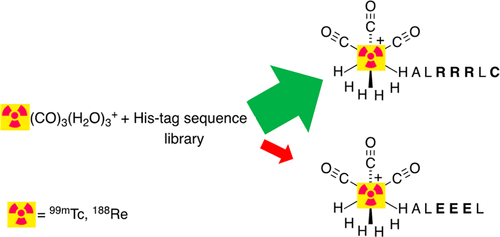当前位置:
X-MOL 学术
›
Bioconjugate Chem.
›
论文详情
Our official English website, www.x-mol.net, welcomes your
feedback! (Note: you will need to create a separate account there.)
Optimal His-Tag Design for Efficient [99mTc(CO)3]+ and [188Re(CO)3]+ Labeling of Proteins for Molecular Imaging and Radionuclide Therapy by Analysis of Peptide Arrays
Bioconjugate Chemistry ( IF 4.0 ) Pub Date : 2020-11-26 , DOI: 10.1021/acs.bioconjchem.0c00561 Jennifer D Williams 1 , Florian Kampmeier 1 , Adam Badar 1 , Kevin Howland 2 , Margaret S Cooper 1 , Gregory E D Mullen 1 , Philip J Blower 1
Bioconjugate Chemistry ( IF 4.0 ) Pub Date : 2020-11-26 , DOI: 10.1021/acs.bioconjchem.0c00561 Jennifer D Williams 1 , Florian Kampmeier 1 , Adam Badar 1 , Kevin Howland 2 , Margaret S Cooper 1 , Gregory E D Mullen 1 , Philip J Blower 1
Affiliation

|
Hexahistidine tags (His-tags), incorporated into recombinant proteins to facilitate purification using metal-affinity chromatography, are useful binding sites for radiolabeling with [99mTc(CO)3]+ and [188Re(CO)3]+ for molecular imaging and radionuclide therapy. Labeling efficiencies vary unpredictably, and the method is therefore not universally useful. To overcome this, we have made quantitative comparisons of radiolabeling of a bespoke Celluspots array library of 382 His-tag-containing peptide sequences with [99mTc(CO)3]+ and [188Re(CO)3]+ to identify key features that enhance labeling. A selected sequence with 10-fold enhanced labeling efficiency compared to the most effective literature-reported sequences was incorporated into an exemplar protein and compared biologically with non-optimized analogues, in vitro and in vivo. Optimal labeling with either [99mTc(CO)3]+ or [188Re(CO)3]+ required six consecutive His residues in the protein sequence, surrounded by several positively charged residues (Arg or Lys), and the presence of phosphate in the buffer. Cys or Met residues in the sequence were beneficial, to a lesser extent. Negatively charged residues were deleterious to labeling. His-tags with adjacent positively charged residues could be labeled as much as 40 times more efficiently than those with adjacent negatively charged residues. 31P NMR of [Re(CO)3(H2O)3]+ and electrophoresis of solutions of [99mTc(CO)3(H2O)3]+ suggest that phosphate bridges form between cationic residues and the cationic metal synthon during labeling. The trial optimized protein, a scFv targeted to the PSMA antigen expressed in prostate cancer, was readily labeled in >95% radiochemical yield, without the need for subsequent purification. Labeling occurred more quickly and to higher specific activity than comparable non-optimized proteins, while retaining specific binding to PSMA and prostate cancer in vivo. Thus, optimized His-tags greatly simplify radiolabeling of recombinant proteins making them potentially more widely and economically available for imaging and treating patients.
中文翻译:

通过肽阵列分析对用于分子成像和放射性核素治疗的蛋白质进行高效 [99mTc(CO)3]+ 和 [188Re(CO)3]+ 标记的最佳 His 标签设计
六组氨酸标签 (His-tags) 结合到重组蛋白中以促进使用金属亲和层析进行纯化,是有用的结合位点,可用于使用 [ 99m Tc(CO) 3 ] +和 [ 188 Re(CO) 3 ] +进行分子成像的放射性标记和放射性核素治疗。标记效率的变化不可预测,因此该方法并非普遍有用。为了克服这个问题,我们对定制的 Celluspots 阵列库的放射性标记进行了定量比较,该库包含 382 个含有 His 标签的肽序列,具有 [ 99m Tc(CO) 3 ] +和 [ 188 Re(CO) 3 ] +确定增强标签的关键特征。与最有效的文献报道序列相比,标记效率提高 10 倍的选定序列被整合到示例蛋白质中,并在体外和体内与未优化的类似物进行生物学比较。使用 [ 99m Tc(CO) 3 ] +或 [ 188 Re(CO) 3 ] + 进行最佳标记需要蛋白质序列中有六个连续的 His 残基,周围有几个带正电荷的残基(Arg 或 Lys),并且缓冲液中存在磷酸盐。序列中的 Cys 或 Met 残基在较小程度上是有益的。带负电荷的残基对标记有害。带有相邻带正电荷残基的 His 标签的标记效率比带有相邻带负电荷残基的 His 标签高 40 倍。[Re(CO) 3 (H 2 O) 3 ] + 的31 P NMR和 [ 99m Tc(CO) 3 (H 2 O) 3 ] +溶液的电泳图表明在标记过程中阳离子残基和阳离子金属合成子之间形成磷酸桥。试验优化的蛋白质,一种靶向前列腺癌中表达的 PSMA 抗原的 scFv,很容易以 >95% 的放射化学产率标记,无需后续纯化。与可比较的非优化蛋白质相比,标记发生得更快,比活性更高,同时在体内保持与 PSMA 和前列腺癌的特异性结合。因此,优化的 His 标签极大地简化了重组蛋白的放射性标记,使它们有可能更广泛、更经济地用于患者的成像和治疗。
更新日期:2020-11-26
中文翻译:

通过肽阵列分析对用于分子成像和放射性核素治疗的蛋白质进行高效 [99mTc(CO)3]+ 和 [188Re(CO)3]+ 标记的最佳 His 标签设计
六组氨酸标签 (His-tags) 结合到重组蛋白中以促进使用金属亲和层析进行纯化,是有用的结合位点,可用于使用 [ 99m Tc(CO) 3 ] +和 [ 188 Re(CO) 3 ] +进行分子成像的放射性标记和放射性核素治疗。标记效率的变化不可预测,因此该方法并非普遍有用。为了克服这个问题,我们对定制的 Celluspots 阵列库的放射性标记进行了定量比较,该库包含 382 个含有 His 标签的肽序列,具有 [ 99m Tc(CO) 3 ] +和 [ 188 Re(CO) 3 ] +确定增强标签的关键特征。与最有效的文献报道序列相比,标记效率提高 10 倍的选定序列被整合到示例蛋白质中,并在体外和体内与未优化的类似物进行生物学比较。使用 [ 99m Tc(CO) 3 ] +或 [ 188 Re(CO) 3 ] + 进行最佳标记需要蛋白质序列中有六个连续的 His 残基,周围有几个带正电荷的残基(Arg 或 Lys),并且缓冲液中存在磷酸盐。序列中的 Cys 或 Met 残基在较小程度上是有益的。带负电荷的残基对标记有害。带有相邻带正电荷残基的 His 标签的标记效率比带有相邻带负电荷残基的 His 标签高 40 倍。[Re(CO) 3 (H 2 O) 3 ] + 的31 P NMR和 [ 99m Tc(CO) 3 (H 2 O) 3 ] +溶液的电泳图表明在标记过程中阳离子残基和阳离子金属合成子之间形成磷酸桥。试验优化的蛋白质,一种靶向前列腺癌中表达的 PSMA 抗原的 scFv,很容易以 >95% 的放射化学产率标记,无需后续纯化。与可比较的非优化蛋白质相比,标记发生得更快,比活性更高,同时在体内保持与 PSMA 和前列腺癌的特异性结合。因此,优化的 His 标签极大地简化了重组蛋白的放射性标记,使它们有可能更广泛、更经济地用于患者的成像和治疗。











































 京公网安备 11010802027423号
京公网安备 11010802027423号